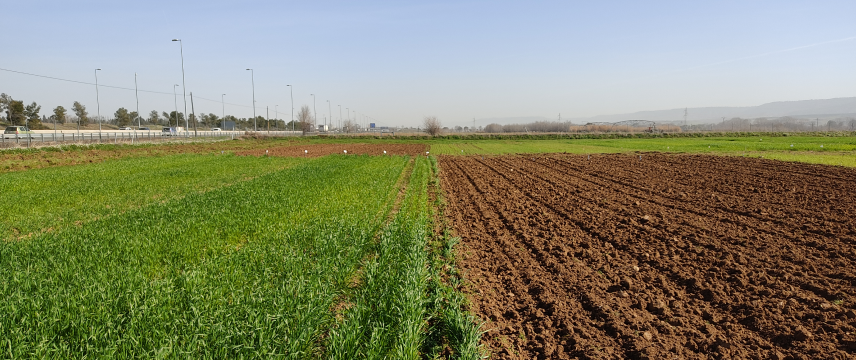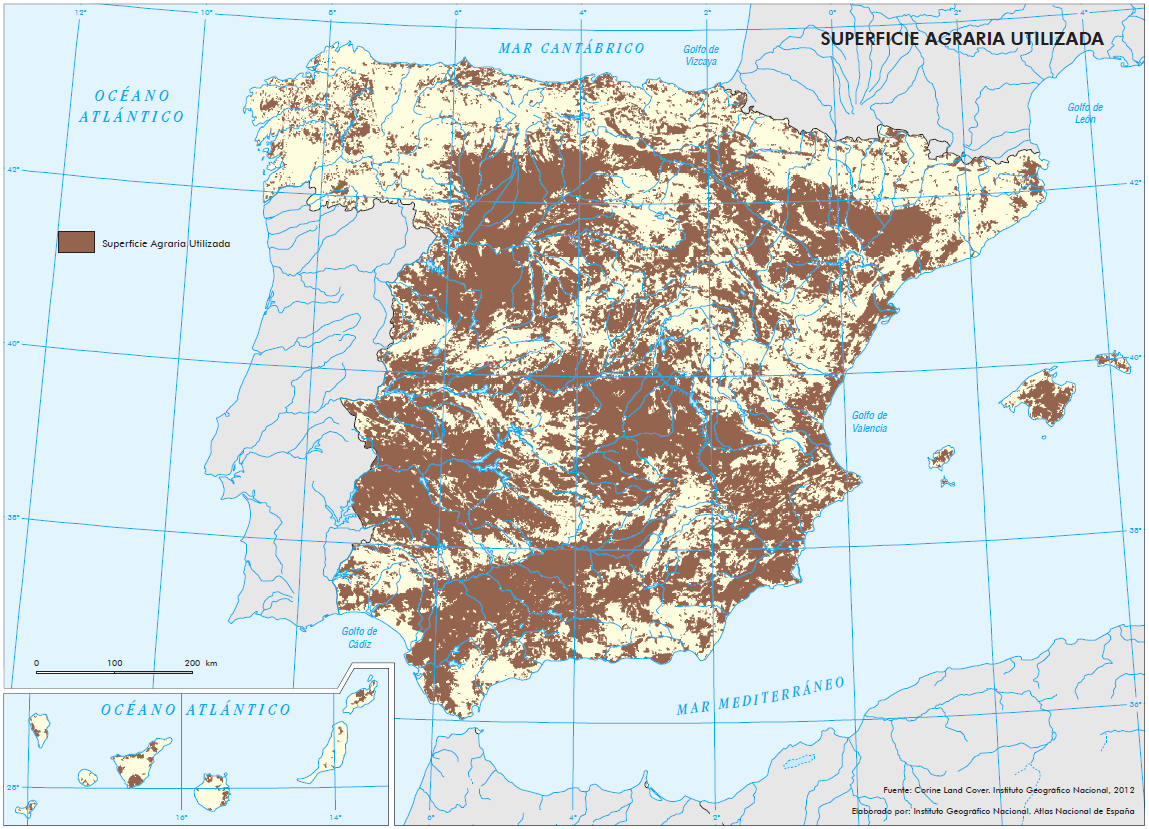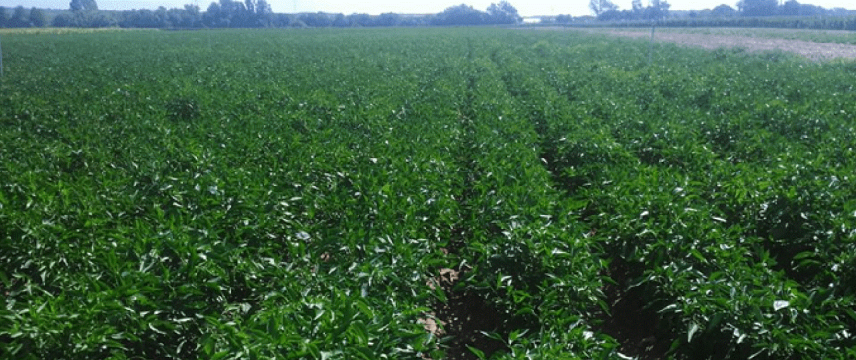Agricultural land in Spain

Almost half of this area is arable land, which includes arable crops, such as cereals, but also land that is fallow. Large climatic variations sustain a wide variety of agrosystems: Permanent pastures and maize prevail in northern Spain, while vineyards, olive and almond orchards, rainfed crops and dehesas (a traditional extensive agroforestry system where pastures and sparse trees co-exist) thrive in its Mediterranean areas. Horticulture and citrus crops are predominant under irrigation and temperate conditions, and maize is also irrigated in some locations. Subtropical fruit crops prevail in the Canary Islands. Soil conditions are also quite diverse, due to dissimilarities in geology, climate, land use, and agricultural crops and practices. For example, the soil organic carbon content is typically low (< 0,5-2%) in arid cropland areas of central and southern Spain while it may reach up to 21% in northern grasslands.
The livestock area of the Iberian Peninsula ranks fourth in the EU in terms of extension dedicated to this activity. As for the number of livestock, in Spain the pork sector stands well above the others, with more than 25 million animals. This is followed in numbers by beef, due to the high volume of production and number of farms.
The edaphic diversity in Spain is very great, with characteristic soils appearing in each region. Calcisols predominate, which are mostly conditioned by the lack of water as opposed to their natural fertility, as these soils are very productive under irrigation.
Therefore, the majority of food production is concentrated in semi-arid areas subject to a high risk of soil loss due to erosion. Inadequate agricultural practices have a negative impact on the quality of soil and water, affecting coastal areas, and the atmosphere, through the emission of greenhouse gases and other air pollutants.

Agricultural used land in Spain (Instituto Geográfico Nacional, 2012)
Challenges for this land type
The challenges for this kind of land are numerous and are listed below
- 84,5% of the agricultural surface of Spain is located in areas which are not considered favourable due to biophysical limitations such as aridity, rockiness and slope.
- Spain is the second country in orography of the European Union, so it has large areas with slope gradients greater than 15%.
- Soil water erosion is the main source of erosion in Europe and this presents a severe risk in the Southern part of the continent. In the EU, 2,4 tons of soil per hectare are lost each year due to this erosion, while in Spain the loss of soil is higher than the EU average: 3,73 t/ha/year.
- In relation to soil organic matter, Spain is the EU country with the lowest average soil organic carbon content, 14,9 g/kg compared to the EU average of 43,1 g/kg and has the lowest value compared to other Mediterranean countries.
- Erosion and the loss of soil organic matter are related to the other soil problems that sustainable soil management faces: contamination, sealing or salinization.
- The intensification of productive activity, including the inappropriate use of synthetic fertilizers and phytosanitary products, or the insufficient treatment or misuse of organic waste increases the risk of soil contamination.
- The health of a soil is determined by the variety of life forms that inhabit it. The loss of soil biodiversity poses a major threat, as this biodiversity plays a critical role in climate change mitigation, water storage and purification, antibiotic development, and erosion prevention.
- The salinization of aquifers is a growing problem and can pose a threat to some productive areas. It is especially worrying in coastal areas of the Spanish Levant, where the productivity of the affected farms may be compromised.
- There has been an increase in the soil-sealing index at EU level, with Spain as the Mediterranean country in which the index has evolved most unfavourably.
- Large areas of Spain are potentially affected by desertification: more than two thirds of the Spanish territory belong to the categories of arid, semi-arid and dry sub-humid areas. This is especially worrying in the Mediterranean basin.
Other hazards are presented by
- The abandonment of agricultural activity in the slope areas causes deterioration of the terraces and accentuates the dragging and loss of fertile soil.
- Soil characteristics are not presented in a generalised or uniform way, while its state of conservation deserves some concern. It is impacted by human activities and its degradation reduces its ability to react to natural phenomena such as erosion and our ability to adapt to the expected impacts of climate change.
Who is affected?
Producers/Farmers, Land Owners, Consumers, Citizens, Public administration (Regional / National), etc.
Possible solutions
Several sustainable agricultural practices (SAPs) have been proposed to tackle those challenges, as they would improve soil physical properties and biodiversity, potentially aiding in pest suppression and increasing crop yield. They encompass No- or Reduced-tillage (NT/RT), crop rotations, ground cover and cover crops, sowing legume-rich mixtures in dehesas, use of organic fertilizers, or increasing efficient fertilization and water management.
What citizens can do
Citizens - as final consumers of agricultural goods and products resulting from the ecosystem services provided by soils - should have a broad vision of everything that agricultural soil implies and its significance: linking soil to human health and focusing on future preparedness in term of facing current challenges and ensuring future sustainability and agricultural productivity.
Moreover, citizens could play a proactive role in supporting monitoring of soil health with the right education and tools and even support producers in understanding the impacts of changes in management practises.
The first steps could involve:
- Make special effort in providing an appropriate education at home concerning the high importance of agriculture and primary production.
- To practise and promote environmentally sustainable food consumption and demand consumption rules to give an extra-bonus for “agriculture-soil friendly products”.
Sources:
- Instituto Nacional de Investigación y Tecnología Agraria y Alimentaria (INIA-CSIC)
- Ministerio de Agricultura, Pesca y Alimentación (MAPA)
- Ministerio para la Transición Ecológica y el Reto Demográfico (MITECO)
- Instituto Nacional de Estadística. Censo agrario (INE)
- Instituto Geográfico Nacional (IGN)
Extremadura
Extremadura covers an area of 4,167,277 hectares, representing 8.2% of the total land for Spain. Agriculture is predominant in this area and accounts for 55.5% of the use of this terrain, with 45% of the total agricultural area formed of pasture. This is followed by forest areas, which account for some 42.1%, 18.3%. of which are wooded. In addition, the high percentage of water areas, which make up 1.7% of land (91% of which are reservoirs), and the low percentage of artificial areas make it significant.
Agriculture plays a very important role in Extremadura and is an element that has shaped its regional identity, the landscape, the personality of its people and its traditions and ways of life. In Extremadura three, fully-consolidated, agricultural and livestock production methods exist: integrated; organic and conservation. All three can be considered to respect the natural environment and recurrently represent a considerable percentage of agricultural land. These production techniques are essentially compatible with the objectives for the transition to a green and circular economy.
In Extremadura, agricultural production is worth around 2,300 million euros and agricultural income represents approximately 1,300 million euros. Progressive annual increases confirm its importance for the region's economy and maintain its continuous growth.

Challenges for Extremadura
The new regional scenario (geared towards sustainable development of the agricultural sector) is characterised by the productive diversification of farms, attention to territorial balance and a greater environmental commitment that favours new production and market niches such as organic farming, a commitment to quality production, direct sales to consumers, local trade and synergies with other economic sectors, which are changing the conventional model.
Among the challenges posed by this sector undoubtedly the geographical and environmental adaptation of crops and livestock to the increase in temperatures and the variation in precipitation due to climate change ranks high as well as taking up the new opportunities arising for the sector from the development of the green and circular economy and promoting the incorporation of new technologies, research and the transfer of results from the agricultural sector for the improvement of productivity and soil without undermining sustainability.
The Green and Circular Economy Strategy Extremadura 2030 aims to unite and align most of the material and human resources in Extremadura in the search of a greener and more circular society and economy, where natural resources provide a permanent source of opportunities for the people of Extremadura. A social and sustainable economy where the people who live in each of the towns and cities of Extremadura are the protagonists of innovation, creativity, the respectful production of goods and services, the creation of green business initiatives and the enhancement of our natural resources.
This strategy also takes as a reference other regional initiatives such as the "Rural Development Programme 2014-2020", which counts achievement of "Environmentally friendly agriculture" by increasing organic farming by 8,200 hectares in the region, among its main challenges.
Who and what is affected?
All the actors of the quadruple helix approach to social innovation are needed for active participation and implementation of the different sectoral strategies and plans envisaged for the 2017-2030 period in Extremadura and namely:
- The institutions responsible for providing the majority of guidelines and resources to regulate the transition process and to coordinate policies and measures through continuous dialogue with the various agents.
- Farmers and livestock producers needed to make far-reaching reforms in the production and farm management model, incorporating sustainable productivity, advances in measures to adapt to climate change, product innovations, the implementation of new technologies, and the adoption of new trends in sustainable and responsible consumption.
- Citizens and their representative organisations, whether favourable or critical of production trends in the agricultural and livestock sector, who will be critical in providing contributions within the framework of participatory regional and local development strategies.
- Research and academic agents, who explore the development or implementation of new products and services and have the resources to finance research personnel, are also essential to the transfer their research results, adapting them to the demand and needs of the sector.
What are the possible solutions?
Below is a list of the possible solutions that could be adopted to meet the challenges identified:
- Extensive livestock farming, holistic grazing and rotational grazing by Voisín
- Imitation of the dynamics of natural systems from practices that enable production, mitigation and conservation: crop rotations with different root systems and different biomass inputs, covered soils that are a refuge for diversity and regulators of temperature and evapotranspiration, input of organic matter of different nature, maintenance of a mosaic of plant diversity (crop and non-crop) to increase soil biodiversity and provide microclimates...etc.
- Use of organic amendments in combination with more sustainable agricultural practices such as conservation agriculture that promote the conservation of organic carbon in the soil (direct seeding, minimum tillage, cover crops, etc.).
- Reducing the use of inorganic fertilisers and increasing their efficiency.
- Use of micro-organisms (mycorrhizae, trichodermas, bacteria, etc.) improved by the use of new technologies, and applied to the soil show a very important substantial improvement in both its structure and biodiversity.
- Soil biology management.
- Use of soil conservation techniques such as terracing, runoff capture, minimal tillage.... prevent soil loss due in particular to extreme conditions.
- Integrated soil-plant decision-making models.
- Prevent and anticipate the likely periods of water scarcity that the sector may face as a result of climate change and changes in rainfall patterns.
- Assess water demands, implement new technologies, make irrigation water use more efficient and implement the necessary infrastructures to ensure sustainable supply.
- Adapt crops and livestock geographically and environmentally to rising temperatures and changing rainfall due to climate change, by redistributing production axes, modifying farm management or through genetic improvement.
- Promote the protection of crops and livestock farms against extreme weather events.
- Provide insurance for crops and livestock production in the event of disasters, as well as subsidies to adapt to climate change.
- Prevent and avoid the proliferation of pests and diseases due to climatic and other factors, the arrival of pests and pathogens through monitoring and study of possible new behaviours, control and training programmes.
- Take advantage of the new opportunities that may arise for the sector with the development of the green and circular economy.
- Encourage the incorporation of new technologies (precision agriculture, soil sensors, drones…), research and the transfer of results to the agricultural sector to improve productivity.
- Facilitate relations between research centres and farmers for the transfer of new knowledge.
- Establish training plans aimed at farmers for the modernisation of farms, sustainable management and the transition to a green and circular economy.
- Promote producer groups.
- Encourage quality production and designations of origin.
- Promote organic production and agro-ecology (techniques & uses), especially at the local level.
What can citizens do?
Citizens have a very high-value contribution to make within the framework of participatory regional and local development strategies mentioned above.